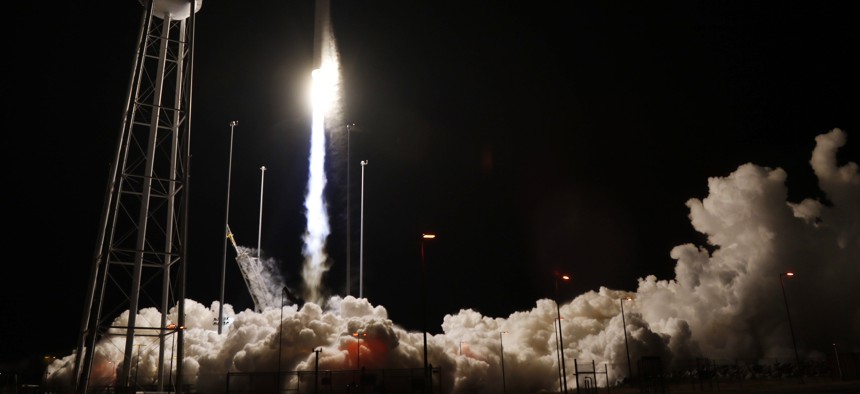
Northrop Grumman Antares rocket lifts off from the launch pad at NASA's Wallops Flight Facility in Wallops Island, Va., Saturday, Nov. 17, 2018. AP Photo/Steve Helber
Space Force Actually May Be Bargain, New Cost Estimate Says
“At this point it may be a coin toss whether or not this makes it through,” says Todd Harrison.
Space Force — the new branch of the U.S. military desired by President Trump — could cost taxpayers as much as $21.5 billion per year, but only $550 million of that would be new money, according to a budget analyst.
The estimate from Washington’s resident defense spending guru Todd Harrison of the Center for Strategic and International Studies argues that creating a Space Force, large or small, amounts to nothing more than a reorganization in which money would be transferred out of the Air Force, Army and Navy into the new military service. Harrison’s estimates assume a version of Space Force smaller than what the U.S. Air Force has proposed, which includes several additional agencies, and closer to what the Pentagon’s Office of the Secretary of Defense is seeking.
“Most of this is just a simple matter of reorganization and whether or not you think that’s worth it,” Harrison said Monday. “The added cost is a handful of F-35s or less than the audit. I don’t think cost actually should be that big of factor in their decision. I think a bigger factor is whether or not it’s needed.”
An Air Force F-35 in fiscal 2020 is expected to cost about $80 million each. Harrison believes a Space Force would only cost between $300 million and $550 million per year in additional funds. Harrison compared the costs for small, medium, and large-sized forces. A lesser Space Corps kept within the Air Force comprised of about 27,300 uniformed military and civilians would cost about $11.3 billion annually, he said. A “Lite” Space Force — of about 35,800 military and civilians would cost about $13.4 billion annually. A “Heavy” Space Force of about 48,500 military and civilian workers would cost about $21.5 billion annually.
“Ninety-six percent of the funding in all three options is not new funding, it’s just transfers from other accounts that already exist in the services,” Harrison said.
Depending on which option is taken, Harrison estimates Trump’s space expansion of the military would cost taxpayers an additional $1.5 billion to $2.7 billion over five years.
Deputy Defense Secretary Patrick Shanahan, who is overseeing the creation of the Space Force, said last week at the Pentagon that it would cost “single digit, not a double-digit” billions of dollars to create the new branch. “It might be lower than $5” billion, Shanahan said.
Harrison said his estimate lines up with the defense secretary’s, but wants to see more than estimates.
“One of the golden rules in budget analysis is never rely on budget data that is presented orally,” Harrison said. “Until he’s written it down, we don’t really know for sure what he meant.”
Lt. Col. Joseph Buccino, a spokesman for Shanahan, said Monday that the deputy secretary estimates last week were over a five-year period.
One unique feature of the expected space service is that more than half of its personnel are expected to be civilian workers, Harrison said. The other services only have a civilian workforce that account for 10 to 36 percent of size. “It would be a more civilian-heavy service than any of the others,” he said.
Harrison’s estimates, however, are vastly different from what the more comprehensive Space Force recommended by the Air Force. His do not include standing up U.S. Space Command, a warfighting combatant command; a Space Development Agency, for overseeing satellite and launch purchases; and shifting intelligence agencies, like the National Reconnaissance Office, into the Space Force.
The Air Force estimate — which concluded about $13 billion would be needed over a five-year period to stand up a Space Force — assumed those additional organizations would fall under the umbrella of the new military branch. Harrison said he stands by a previous criticism of that estimate, which he called “an example of malicious compliance.”Air Force Secretary Heather Wilson, speaking last week at the Defense One Summit, defended her estimate.
“Our cost estimate that we gave to a lot of people in the Pentagon in September was the cost of a fully-fledged, stand-alone department and also a unified combatant command,” Wilson said. “What we put forward was cost estimates to implement a stand-alone department.”
A senior defense official, speaking on background, said Harrison’s Space Force does not take into account buying new satellites or creating missions that would improve the U.S. military’s space warfighting capabilities.
“It just shuffles the deck in the hope of drawing a better hand,” the senior official said. “It’s Space Force on the cheap. In more direct terms, it doesn’t solve any problems.”
Harrison said he did not include the intelligence agencies in his estimates because their budgets are classified. An early draft of the Pentagon’s Space Force proposal, which it plans to send to Congress in February, does not propose moving NRO into the new military branch.
Despite Trump’s desire to create a Space Force, in the end, a spit Congress, with Republicans controlling the Senate and Democrats the House, will have the final.
“I would say at this point it may be a coin toss whether or not this makes it through,” Harrison said.




